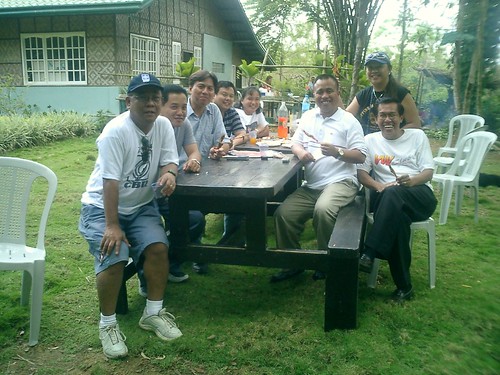At Large : World-class and made in Cebu
Rina Jimenez-David
Inquirer News Service
CEBU -- There is a long tradition of shipbuilding in this province. I remember a claim made some time ago that the reason Cebu has lost much of its forest cover (explaining its current problems with water supply) is that the province's trees have been cut down indiscriminately since Spanish times, for lumber to be used in building ships for the galleon trade and for wars.
The San Diego exhibit in this city's historic Fort San Pedro gives testament to Cebu's proud heritage of shipbuilding. The Spanish-era ship San Diego was constructed in Cebu in the 1600s, originally as a trading vessel until, on its last voyage, it was hurriedly conscripted into the naval service to do battle with Dutch ships off the coast of Batangas province, where it sank with its cargo of porcelain ware and pottery. In the 1990s, a French exploration company funded the location and excavation of the San Diego, bringing to light the country's rich trading history and Cebu's own shipbuilding heritage.
Well, that proud history and tradition of crafting sea-going vessels lives on in Cebu. Visiting with my family over the weekend, we proceeded from the airport to the town of Balamban, on the western coast of the province, facing Negros Occidental province.
Our visit transpired after I learned that some of my frequent flyer miles with Philippine Airlines were about to expire and after my daughter Miya complained that she had never yet set foot on Cebu. The visit to the FBMA shipyard in Balamban had been suggested by my friend and sister in the Pilipina organization, Alice Morada, a lawyer with the Aboitiz group of companies, when I asked her what places we could go to, besides the usual tourist spots. "The reason I am suggesting the place," wrote Alice, "is because 'nakakataba sa puso' [it's heartwarming] to see what Filipinos are capable of doing -- 'talagang' [truly] world-class."
* * *
ORIGINALLY a partnership with FBM Babcock, an international UK-based firm, but now completely owned by the Aboitiz group, FBMA (the A is for Aboitiz) provides both design and construction/manufacture services for different types of seagoing vessels-from passenger and vehicle ferries, paramilitary vessels, landing craft, crew boats and other "specialist" craft which are designed and constructed in Balamban and, from there, shipped to different parts of the world.
Most recently, FBMA landed in the front page of this paper when it launched its biggest vessel yet, a ferryboat for use in the Netherlands.
To reach Balamban, we traveled for a little over an hour by land through Cebu's Transcentral Highway. On the map, it looks like a fairly straightforward route, little realizing the highway winds through hills and mountains. At one point, though, the mountain view opens on one side to a breathtaking vista of the waters surrounding Cebu province: the Bohol Strait, Tanon Strait and the Camotes Sea.
Our guide to FBMA was Dave Prodger, who described himself as a "big, fat white man" who would be standing by the roadside in front of the gate to the Cebu Export Processing Zone where the shipbuilding facilities are.
Prodger is actually British, a welder who came to Balamban about eight years ago to train welders at FBMA, and eventually married one of them, the lone woman trainee among the first batch. They now live in Balamban with their two daughters, though Prodger's wife has since ceased wielding torches.
* * *
TWO vessels, of a design that was decidedly unusual, being a double-hulled catamaran (I hope I got this right!), were under construction when we came to visit. To our untrained eyes, though, the vessels, fashioned out of aluminum, seemed straight out of science-fiction films, looking like spaceships and huge star fighters.
The reason for the design, said Prodger, was that the vessels needed to be stable in the open seas, since they would ferry workers from the shore to oil rigs and would need to be as stable as possible for off-loading or boarding. The ships were under contract to FBMA by Lockheed-Martin for delivery to Mexico. Next door was another huge vessel, this one made of steel, awaiting completion, but on which work had been halted because the client had temporarily run out of funds.
Save for Prodger and a few other foreign management hires, an all-Filipino crew, including designers who either make specifications on clients' designs or work on vessel designs from scratch, work on the vessels that roll out of the FBMA shipyard. "Majority of our workers (nearly 200 of them) come from Balamban or the general area," said Prodger, though FBMA also provides training to apprentices from the Don Bosco school. As a project nears delivery, though, representatives of the various foreign suppliers-for the engines or interiors, for instance-as well as of the buyers stay on to see the vessels' completion.
* * *
INDEED, we felt a surge of pride after we left the work floor and walked along the corridors leading to Prodger's office. Lining the walls were blueprints of various vessel designs and framed photos of completed projects, with FBMA management and clients surrounded by workers in their dark-blue overalls and hard hats. It was heady to imagine all these vessels operating all around the world, testimony to the skill and industry of Filipino workers.
Prodger concedes that FBMA at the moment is facing tough competition from Chinese shipbuilders, who can afford to slash costs because of cheap labor. What would be FBMA's edge over the cheaper competition? "I would have to say our experience and the quality of our work," said Prodger proudly, pointing to a picture of a vessel sent to Scotland, two of which were made in FBMA and another two made in Scotland. "The ones we made are the ones still being used because they were better made!" he boasts.







No comments:
Post a Comment